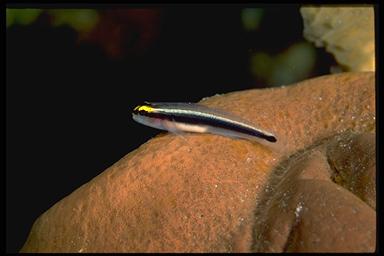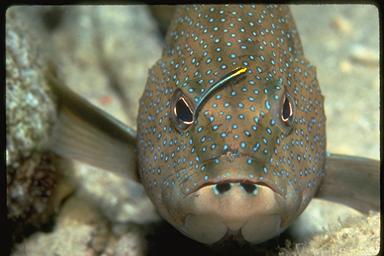Cleaning Goby (Neon Goby)

There are two fish species commonly called cleaning gobies or neon gobies: Elacatinus evelynae and Gobiosoma randalli.
In fact, I hate to admit it, but the two species look so similar to one another that I'm uncertain as to whether the photos on this page depict Elacatinus evelynae or Gobiosoma randalli. Their behavior and care requirements are similar to one another and so the information in this article is pertinent to either species of cleaning goby.
Like all of the gobies they both belong to the family Gobiidae.
They are small saltwater fish and only reach an adult size of 1.5 inches (4 cm).
Both fish species are often sold in pet stores as cleaning gobies or neon gobies. In fact, there are many small cleaner gobies that are commonly sold under the name "neon goby." These neon gobies generally come in a variety of colors and their size, behavior, and feeding requirements are similar to the two goby species mentioned already.

In general, I find all of the bottom dwelling fish, such as the gobies, interesting. What makes cleaning or neon gobies especially interesting is that they provide a cleaning service to other ocean and aquarium fish by eating the external parasites off of them. The photo on this page shows a sharknose goby cleaning a coney grouper (Cephalopholis fulva). In fact, fish enjoy this cleaning service so much that they often line up in order to get their turn at a cleaning.
Goby Aquarium Care Requirements
Cleaning gobies are pretty hardy little fish and they usually do well in captivity. They often spawn in the aquarium.
While it is true that they will eat external parasites off of other fish, you will still need to supplement their diet. Feed your cleaner gobies marine foods for carnivores - mysid shrimp, brine shrimp, finely chopped seafood, and other meaty-based preparations for saltwater fish.
In addition, you should provide them with plenty of well-established live rock. Cleaner gobies not only graze on the live rock, but they also use it for hiding places. Almost ALL fish feel more secure when they have places to hide.
They are excellent fish for reef tanks. You can keep several cleaner gobies in your aquarium as a small group. I wouldn't keep small cleaner gobies with large, aggressive fish.
You can usually obtain cleaner or neon gobies for about $22-25. You can often find tank-raised gobies. Buying tank-raised saltwater fish is usually the best option. This is because fish removed from their natural environment are often very stressed and it takes them a little while to get used to life in captivity. If you buy tank-raised specimens confinement to an aquarium is all they've ever known and so they aren't nearly as stressed. Why is this important? Because stressed fish are less healthy, not to mention not as happy.
Gobies will often spawn in the aquarium (which is where those tank-raised gobies came from). Spawning usually takes place in caves. Many aquarists place pvc pipe in their aquarium for their cleaner gobies to spawn in.
Males and females look similar to one another and they usually form monogamous male-female pairs. Research has shown that female cleaning gobies actually do more "cleaning" than the males, perhaps because of their greater nutritional needs for spawning (Whiteman and Côté, 2002).
Both parents usually guard the eggs, which hatch in a few days.
Elizabeth A. Whiteman and Isabelle M. Côté (2002). Sex differences in cleaning behaviour and diet of a Caribbean cleaning goby. Journal of the Marine Biological Association of the UK, 82, pp 655-664.
